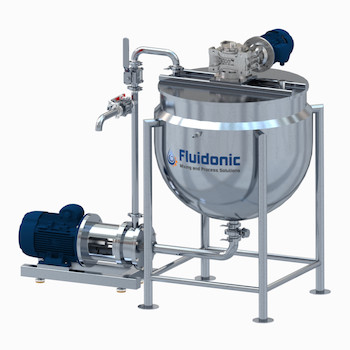-
Ingredient Storage and Handling:
-
Ingredient Silos or Storage Tanks:
- Store bulk quantities of ingredients such as oil, egg yolks, vinegar, and other additives.
- Ingredients are pumped from these storage tanks to the mixing and emulsification process.
-
Weighing and Measurement:
-
Ingredient Weighing Systems:
- Ensure accurate measurements of each ingredient based on the recipe.
- Automated systems may be used for precise weighing.
-
Pre-Mixing and Blending:
-
Pre-Mixing Tanks:
- Combine specific quantities of oil, egg yolks, and other liquid ingredients in pre-mixing tanks.
- Preliminary blending helps prepare the ingredients for the emulsification process.
-
High-Speed Disperser:
-
Emulsification Stage:
- Use a high-speed disperser to break down the oil phase and disperse it into fine droplets.
- Achieve a stable emulsion by combining the oil phase with water-based ingredients.
-
Inline Homogenizer:
-
Fine Emulsification:
- Pass the emulsified mixture through an inline homogenizer for further refinement of particle size and improved stability.
- Creates a smooth and consistent texture in the mayonnaise.
-
Vacuum Deaeration (Optional):
-
Deaeration Equipment:
- Remove air bubbles from the mayonnaise to enhance its stability and prevent separation.
- Vacuum deaeration is an optional step.
-
Cooling:
-
Jacketed Cooling Tanks:
- Cool the mayonnaise to the desired temperature using jacketed cooling tanks.
- Controlled cooling helps set the emulsion and improve the viscosity.
-
Seasoning and Flavor Addition:
-
Seasoning Tanks:
- Introduce seasonings, herbs, spices, and other flavorings to the mayonnaise.
- Ensure thorough mixing for uniform flavor distribution.
-
Quality Control and Adjustments:
-
Quality Testing Stations:
- Conduct quality checks for taste, texture, and appearance.
- Make any necessary adjustments to meet quality standards.
-
Packaging:
-
Packaging Machines:
- Fill the mayonnaise into containers, jars, or other packaging formats.
- Automated filling and packaging equipment may be used for efficiency.
-
Cleaning-In-Place (CIP) System:
-
Equipment Cleaning:
- Implement a CIP system for thorough cleaning of the production equipment, ensuring hygiene and preventing cross-contamination.
-
Storage and Distribution:
-
Finished Goods Warehouse:
- Store packaged mayonnaise in a dedicated warehouse before distribution.
- Mayonnaise may be distributed to retailers, supermarkets, or other outlets.
Additional Considerations:
-
Automation and Control Systems:
- Modern mayonnaise preparation plants often incorporate automated control systems for precision and efficiency.
-
Hygiene and Sanitation:
- Adherence to strict hygiene and sanitation standards is critical to ensure the safety and quality of the mayonnaise.
-
Batch or Continuous Production:
- Mayonnaise production can be organized as batch processes or continuous processes, depending on the production scale and facility design.
A well-designed mayonnaise preparation plant integrates various stages and equipment to produce mayonnaise efficiently, meeting quality standards and ensuring a consistent product for consumers.
